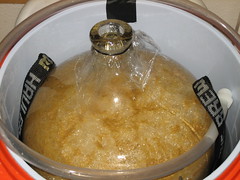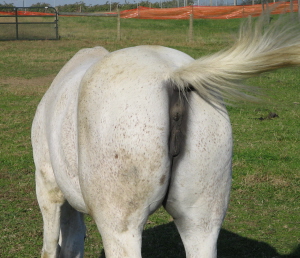jcarson83
Well-Known Member
I've got the same cold water tank cooler. I cut a hole in one of the cup holders to run the hoses and cord through to keep it sealed better.

Here are some pics of my incarnation of the chiller system:
brew1 on Flickr - Photo Sharing!
brew3 on Flickr - Photo Sharing!
brew2 on Flickr - Photo Sharing!
brew4 on Flickr - Photo Sharing!
I started with the thermowell (thermistor??) directly in the carboy, but I ran into an issue. When the system kicked on, it would pump so much freezing cold water into the chiller that it would push my fermentation temp 4-5 degrees lower than my target. Now that it is in the chiller water, I just set the temp controller about two degrees lower than my target fermentation temp and it works great. Hopefully the brew will taste good too.
As time goes on, I plan on sealing the system for better temperature insulation. I'm looking forward to trying a lager on this thing!
Thanks again to JCarson for the concept.




Anyone ever think about connecting this system to a water dispenser unit? I see them on craigslist from time to time for about $40. Some have both a hot and cold ports. With a dual stage controller you may be able to heat and cool.
GE Hot & Cold Free Standing Water Dispenser - GXCF05D at The Home Depot
Don't think about TEMPERATURE, think about HEAT. There is a fixed amount of HEAT produced by fermentation, and the slower the fermentation, the slower the release of heat. The larger the volume, the more thermal mass there is to absorb the heat.
It's about 140 kilocalories per kilogram of extract* fermented.
I believe that if a temp probe taped to the side of a fermenter in open air is accurate within a degree, then the same probe in a water bath should be within a degree.
I use this system too.

*Meaning sugar.
I think that might be going a step beyond the low cost and multifunctionality point of these sytesms. When not used as such they revert back to coolers etc and are fairly low budget items.
On the other hand that sounds like a pretty cool idea if neither of the above are of concern. My only concern if you were able to work out the engineerding part would be that the hot water supplied would be too hot and you may very well overshoot your desired temp.


I put one of those fabric box shaped coolers over the top of my water cooler to provide additional insulation.

Yup. 40-55 for lager yeasts in most cases.
Cool - large ice blocks - hmm..I bet they do last a good bit longer
I agree that 33-35F is ideal, but John Palmer's How To Brew says this:
Nominal lagering times are 3 - 4 weeks at 45°F, 5 - 6 weeks at 40°F, or 7 - 8 weeks at 35°F
With a few adjustments, I've been holding the temp at 38F for the last two days. It's a little more maintenance with the daily ice changes, but I don't mind the extra effort. Staying involved in the process is fun for me as a new brewer. Keeping within 3 degrees of 35F should lead to a good beer.




Have you thought about doing a system that doesnt have the carboy sitting in water? Im trying to figure out how to do something similar, but using copper tubing and a insulating material and having the cold water run through that so it cools just the same. Would that be an option of using the cooler, and run a similar setup to what youve created?

Got a pic of your set up with the fabric box cooler lid on top?
I think your main issue is that your fermentation cooler isn't insulated enough. One more thing you might look into is to create a false top to your fermentation cooler from Styrofoam. Something that would be as airtight as possible with holes in it for everything you have going in/out of it. You could throw some of the reflective bubble wrap insulation they use for water coolers around your cooler too.
I put one of those fabric box shaped coolers over the top of my water cooler to provide additional insulation.
Any ideas on how to push it down to the mid to hi 30's?
I'd like to lager below 40 if possible.
but might also corrode your pump over time if its a cheap one.
yes dan, but that would need to constant refilling, and if your carboy drops to low in temperature, you would have to dump all your water, ice, and salt out, thats the reason for having the pump. its a safer regulation method. the idea of it is that a) the water inside the cooler holding the carboy is at lets say 60 degrees, the water and ice with your pump in the second cooler is about 40. if your brew needs to be sustained at 60, and you have constant 40 degree water in there, it probably will not turn out correct. however with 40 degree water cycling with the 60 water, the warm water gets dumped to the ice cooler, and is replaced by the cold water, keeping the carboy at a steady 60 degrees.
Wouldn't it be easier to just keep the carboy in an ice bath rather than bothering to pump the water from the other cooler? Also, dump some rock salt into the water, that will help it reach a lower temperature, just like making ice cream.
Enter your email address to join: